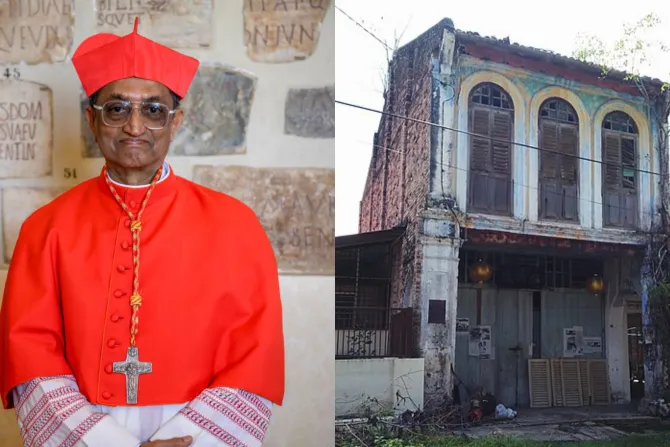By Kate Quiñones
Malaysia’s Cardinal Sebastian Francis, bishop of Penang, has called for the beatification and canonization of Sybil Kathigasu, a heroine and lay martyr who protected information and housed and nursed local members of the anti-Japanese resistance.
During the Japanese occupation of Malaya in World War II, Kathigasu — a wife, mother of three, nurse, and devout Catholic — was imprisoned, beaten nearly to death, and left crippled for healing a rebel guerrilla fighter of his bullet wounds.
At the start of the occupation, Kathigasu hung an image of the Sacred Heart on her wall. It concealed a peephole. On the worst nights after her arrest, imprisoned and isolated, she clung to a rosary. Once released, she went immediately to a church. Unable to walk because she was paralyzed due to a severe beating, she crawled down the aisle of St. Joseph’s Church in Batu Gajah, Perak, offering thanksgiving to God.
The bishop of Penang has appointed Father Eugene Benedict from the Archdiocese of Kuala Lumpur to investigate Kathigasu’s life to determine whether to move forward with her beatification cause.
Devotion in War
Kathigasu lived an ordinary life before the war began. She was born in Medan, Sumatra, in Indonesia to an Irish-Eurasian planter named Joseph Daly and his wife, Beatrice Matilda Martin, a midwife. She was their fifth child and only daughter.
They raised her in the Catholic faith and were concerned when she fell in love with Abdon Clement Kathigasu, a Hindu doctor. When he asked her father’s permission to wed her, Abdon assured him he would join the faith so important to their family.
They were married on Jan. 7, 1919, and had their first son, Michael, just nine months later. Michael died 19 hours after his birth on Aug. 26, 1919, and Sybil’s mother suggested they adopt a son, William. Their first daughter, Olga, was born less than two years later, on Feb. 26, 1921, and Dawn, their youngest daughter, came into the world on Sept. 21, 1936.
Beginning in 1926, the couple ran a private medical practice in Ipoh town in Malaya. Signs of war interrupted their happy lives in 1941 when Ipoh was bombed. Abdon, struck by shrapnel, had to be rushed to the hospital and operated on.
It was the start of the Japanese occupation of Malaya. The family moved to the outskirts of Ipoh for safety, in a small tin-mining town called Papan. They lived in the shophouse of a friend at No. 74 on Main Street.
The Japanese police, known as the Kempeitai, came to occupy Ipoh, enforcing strict laws and using torture to investigate any suspects, including a Japanese form of waterboarding called “water treatment” in which the perpetrator forces gallons of water down a victim’s throat and then stamps on victim’s stomach.
Kathigasu and her husband followed the news via an illegal shortwave radio they nicknamed “Josephine.” They treated patients throughout the war, giving their services for free to those most in need. When a guerrilla stumbled into their clinic with bullet holes in his leg, they helped him. Kathigasu provided medical care, information, and shelter to the anti-Japanese resistance.
Word spread of the rebel midwife. Her husband was arrested in July 1943, and a month later, she was too.
During their imprisonment, Kathigasu and her husband were interrogated and beaten, and Abdon was given the water treatment three times. Kathigasu was beaten and questioned but prayed her rosary, refusing to give any information to the Kempeitai.
The psychological and physical torture reached its peak when Kempeitai Sgt. Eiko Yoshimura kidnapped the couple’s daughter Dawn, who was 5 years old at the time. The officers tied her to a tree and set it on fire in front of Kathigasu, threatening to cut the ropes holding her above the fire if Kathigasu didn’t talk. Kathigasu was bound and beaten with a stick.
“Be very brave, Mummy,” she recalled her daughter saying in her autobiography. “Do not tell them anything.”
Kathigasu didn’t tell them anything. The officers began to cut the ropes. But they took pity on the young girl and brought her down into safety.
Kathigasu chastised Yoshimura for his actions, and he beat her, kicking her face so badly that she would ultimately die from the injury to her jaw.
Kathigasu and Abdon were brought to Batu Gajah prison, a more humane location that served three meals a day. She was tried for her crimes — which Yoshimura had told her would result in death. She was accused of being a spy for the rebels, spreading British propaganda, and being a medic to the rebels.
Kathigasu lost the use of her legs, experiencing paralysis from a previous beating, but she was sentenced only to life imprisonment rather than death. Her husband and son were given 15 and three years respectively.
They were freed in 1945 after Germany’s surrender, shortly before Japan’s surrender in WWII. The Malayan guerrilla rebels brought the fall of the Japanese occupation in Malaysia.
Kathigasu visited St. Joseph’s Church after the release, praying in thanksgiving though she had to crawl, not walk, down the aisle.
She was quickly flown to London for medical treatment, where she wrote her autobiography, No Dram of Mercy, which was published after her death in 1954. The written statements were used in a trial against Yoshimura, who was executed by hanging for his war crimes.
King George VI awarded Kathigasu the George Medal at Buckingham Palace for her bravery.
On June 12, 1948, at the age of 49, Kathigasu died of sepsis — blood poisoning — in her jaw. She was buried in Scotland, but her body was returned to Ipoh a year later, and she was re-buried in St. Michael’s Church. Her husband died 24 years later, in December 1972.
Sybil Kathigasu’s Legacy
Kathigasu has been honored in Malaysia and across the world. A road in Ipoh was named for her, and the shophouse clinic remains standing as a memorial to her.
On June 28, 1948, she was honored in Time magazine for her bravery and medical aid. A TV series was produced about her in 2010 and on Sept. 3, 2016, she was the subject of a Google doodle, standing in front of the shophouse, surrounded by the ribbon of the George Medal. Filmmakers are currently researching and casting for a biopic about her, which is set to come out in the coming years.
Kathigasu is also honored by Catholics. Pilgrims visit her graveside at the Church of St. Michael and the shophouse. During the 2019 Year of Mission, she was honored in Malaysia as one of five examples of witnesses to the Church’s mission. A chapter of the Malaysian catechetical series is dedicated to her; a wing in the Church of St. Joseph, Batu Gajah, Perak, is named for her.
In a July 1 announcement, Cardinal Francis lauded Kathigasu for her “life of service in love and compassion for the sick and suffering” and noted that this year marks the 76th year since her passing.
“We will do well to revisit her life and works to find inspiration for our times,” he continued. “I wish that efforts be made to gather, compile, study, reflect, and make available her life and work as a testimony to us. I hope to advance her cause for beatification and canonization by God’s grace.”
The beatification process requires both verification that the candidate lived a holy life and a miracle granted through intercession to that candidate. Canonization requires a second miracle.
“I see this as an opportunity to bring together and reflect on her life for us as people of faith,” the cardinal wrote. “I wish that we would undertake the cause of Sybil Kathigasu as an example and inspiration of Gospel living.”
“Her life example draws us to the fact that what motivated her is the faith that was instilled in her by her family, that enabled her to live a life marked by a spirituality of dependence on God’s grace and the love of Jesus that filled her with hope in her life, and her love for the suffering and needy in normal situations and circumstances of conflict,” he added.
“Her story continues to inspire many people from all walks of life in society till today,” he wrote. “She inspires people across all cultures and faiths.”
Photo credit:
Malaysia’s Cardinal Sebastian Francis, bishop of Penang, has called for the beatification and canonization of Sybil Kathigasu, a heroine and lay martyr who protected information and housed and nursed local members of the anti-Japanese resistance. Her former clinic and house, now abandoned, still stands in the village of Papan in Lahat, Malaysia. | Credit: Antonio Masiello/Getty Images and Mzdannial, CC BY-SA 4.0, via Wikimedia Commons
This article was first published by Catholic News Agency, EWTN Norway’s news partner, and has been adapted by EWTN Norway.




